
ALSDE PARENTS HOME
TECHNOLOGY SURVEY
2300 Capital Hall | Box 870240 | Tuscaloosa, AL 35487 | 205-348-2085 | evaluation.ua.edu

Page | 2
Contributing Authors
Dr. Karl Hamner
Dr. Behzad Mansouri
Dr. Paria Jami
Lynette Campos
Courtney Greene
Dr. Faron Hollinger
Dr. Dee Fowler
The University of Alabama
The University of Alabama
The University of Alabama
The University of Alabama
The University of Alabama
The Akribos Group
The Akribos Group
Table of Contents
Introduction ..................................................................................................................................... 4
Demographic Information ............................................................................................................... 4
Main Theme of the Report .............................................................................................................. 5
Internet Access ................................................................................................................................ 7
Technology Access ......................................................................................................................... 8
Alabama Public Television ............................................................................................................. 9
Parents’ Preparedness to Support Students Learning ................................................................... 11
Students’ Learning Performance at Home .................................................................................... 11
Remote Learning Utilization......................................................................................................... 14
The Importance of having Before and After School Academic Resources .................................. 15
Recommended Next Steps ............................................................................................................ 16
Appendix A. Group Comparison .................................................................................................. 18
Appendix B. Initial Analysis......................................................................................................... 20
Page | 4
ALSDE Parents Home Technology Survey
Introduction
The ALSDE Parents Home Technology Survey was designed and administered through The
Innovative Programming Research Collaborative, a strategic partnership between The Office of
Evaluation Research in The University of Alabama’s College of Education and The Akribos
Group. The main aim of administering the Parents Home Technology Survey was to explore how
parents perceived their own and their school-aged children’s adaptation to remote and blended
learning options throughout the state of Alabama due to COVID-19. More specifically, the aim
was to explore a statewide school technology list detailing Internet connectivity and device
availability. The survey is composed of several sections including demographic information,
parents’ approach to the upcoming school year, access to internet and technology, usage of the
Alabama Public Television educational program (APT) and other online educational resources,
students’ learning performance during COVID-19, and parents’ opinion about the importance of
having educational resources. After removing incomplete responses, data was collected from
26,174 parents from various school districts in the state of Alabama.
Two types of analysis were conducted to the data collected from parents. First, a descriptive
analysis was performed to explore the variations in the responses and locate any noteworthy
observations. The second round of analysis was conducted to identify any differences between
the responses provided by parents who are planning to send their children to school in the
traditional classroom setting (Group 1) for the fall 2020 semester and those who are planning to
utilize remote learning (Group 2) for the same semester. In other words, the second analysis shed
light about parents’ perspectives regarding the factors associated with utilizing the remote
learning. For the sake of keeping the report concise and informative, only those correlations that
reached the significant level are reported.
Demographic Information
The questions in this section were related to the number of children and the number of school-
aged children in each household (i.e., elementary, middle/ junior high school, and high school)
along with the number of students attending special school programs. On average, there were
two children in each household with at least one of them of school age. The majority of parents

Page | 5
reported having at least one child in elementary school. Forty-one percent of parents reported
having children assigned to special school programs; the most common placement (16%) was in
advanced placement courses. Table 1 and Figure 1 provide a summary of school-aged children at
each level and children attending special programs at schools.
Table 1. Distribution of Students in Each School Level
Percentage
Count
Elementary school-aged children
66%
17,219
Middle/ Junior high school children
43%
11,241
High school children
42%
11,028
Figure 1. Distribution of Students in Special School Programs
Main Theme of the Report
The main theme of the report is related to parents’ willingness to send their children to school
this fall semester. Out of 26,174 responses, 65% of parents (N = 16,992) stated that they were
planning to send their children to school, while 35% of parents (N = 9,182) stated that they did
not plan to send their children to school. Sixty percent of parents (N = 2,065) with a child in a
special education program reported planning on sending their kids to school. Additionally, 64%
(N = 11,074) of parents with a child in elementary school, 62% (N = 6,985) of parents with a
12%
13%
16%
59%
0% 10%20%30%40%50%60%70%80%90%100%
Special Education
Gifted Education
Advanced Placement Courses
No, my children attend conventional classes.

Page | 6
child in middle/ junior school, and 65% (N =7,215) of parents with a child in high school stated
that they would send their children to school. As evident in Figure 2, the main reasons for those
who were concerned about sending their children to school were COVID-19 and health issues.
Similarly, 71% of parents stated that they were not comfortable allowing their kids to ride the
bus to school because of a health concern (Figure 3). It should be noted that some of the
questions required written comments for which we conducted thematic analyses. The results are
illustrated in forms of word-clouds with word/word cluster in varied sizes. The larger the
word/word cluster on word-clouds means that a word/word cluster was more commonly
reported. Appendix A summarizes the responses to all questions based on parents’ willingness to
send their children to school.
Figure 2. Parents’ Concerns for not Returning to Traditional Classroom

Page | 7
Figure 3. Parents’ Concerns for not Using School Bus
Internet Access
Questions in this category were related to the level of internet access both inside and outside
each household. Eighty-one percent (N = 21,189) of the respondents reported having high-speed
internet service available where they live compared to 15% (N = 3,971) who reported that they
did not have high-speed internet service. The majority of respondents, 70% (N =18,265) reported
having high-speed internet at home, whereas the rest reported either having low-speed internet
service, or they access the internet through their cell phones. This means that the majority of
respondents (78%) could stream a YouTube or other videos at home without freezing. Yet, 22%
of respondents were not able to stream videos from YouTube or other sources without any
interruption. With regard to having internet access outside the household, family, work, and
libraries were the most common places for internet access where children could do their
schoolwork. There was no significant difference in high-speed internet availability between
parents who were willing to send their children to school (Group 1) and those who preferred not
to send them to school (Group 2). Figure 4 illustrates the comparison of internet availability
between the two groups.

Page | 8
Figure 4. Comparison of Internet Availability at Home between Group 1 and Group 2
Technology Access
Questions in this category were related to the type and number of technological devices either
available at home or received from school. It should be noted that some of the questions
collected more than one response, and respondents could select as many options as they wanted.
The most frequent personal device available at home was a smart phone (87%) followed by a
laptop (68%) and an iPad (44%). Sixty-nine percent of parents (N = 18,105) stated that their
child had a personal technological device with internet access. On average, there were at least
two personal technological devices in each household which could be used by K-12 children.
Additionally, 67% (N = 17,437) of K-12 children did not need to share their devices while doing
their homework. Yet, 33% of K-12 children needed to share technological devices with at least
another sibling to do their homework.
In regard to receiving school-issued technological devices, most parents (59%) reported they did
not receive any device from school. Among the 41% of parent who received a school-issued
device, Chromebook was the most common technological device. Most (73%) respondents stated
that they have a television with cable, a satellite dish, or an antenna. The remaining respondents
stated they either had a television without cable (25%) or did not have a television at home (2%).
70%
18%
2%
9%
1%
70%
19%
2%
8%
1%
0%
10%
20%
30%
40%
50%
60%
70%
80%
90%
100%
I have high
speed internet.
I have internet,
but it is not high
speed.
I do not have
internet in my
house.
Only my phone
has internet.
I have no access
to the internet.
Internet Availibility at Home
Return to school Remote learning

Page | 9
Alabama Public Television
Fewer than one-fifth (N = 4,085; 16%) of the respondents knew about the Alabama Public
Television Learn at Home (APTLH) broadcast, whereas the rest of the participants (84%) did not
know about the program. Among those who knew about the program, only 25% (N = 687)
watched it. Eighty-five percent of those who did watch APTLH (N = 584) found the program and
the related supplemental material helpful. As depicted in Figure 5, PBS Kid was the most
common resource utilized and found to be the most helpful.
Figure 5. Most Helpful Programs on APT
Out of the 26,174 responses collected, 55% (N =14,266) reported using other online educational
resources to support their children’s learning. As depicted in Figure 6, the most frequent online
educational resources were ABC Mouse, Khan Academy, YouTube, and Google Classroom.
There was a very small statistically significant difference between the two groups (parents
sending their kids to school and those preferring remote learning) with respect to using online
resources (Figure 7).
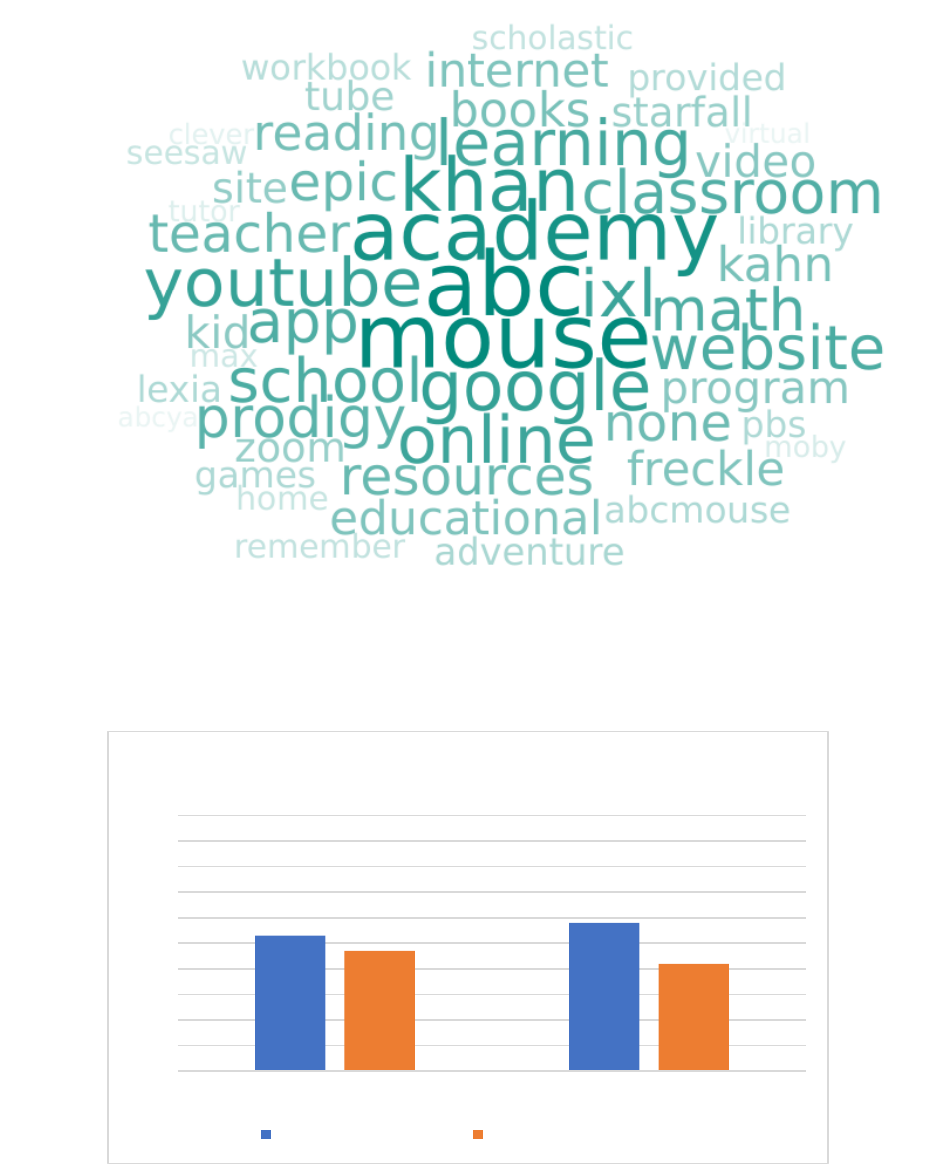
Page | 10
Figure 6. Most Common Online Education Resources
Figure 7. Comparison of Using Online Educational Resources between Group 1 and Group 2
53%
58%
47%
42%
0%
10%
20%
30%
40%
50%
60%
70%
80%
90%
100%
Return to school Remote learning
Use of Online Resources
Using online resources Not using online resources
Page | 11
Parents’ Preparedness to Support Students Learning
Three questions in this category asked about how much parents with a child or children in each
school level (i.e., elementary, middle/ junior high school, high school) were prepared to support
their children’s learning at home. Among 17,219 parents with children in elementary school,
43% felt prepared to support their children’s learning from home. On the other hand, 21% did
not feel that they could support their children’s leaning at home. Out of the 11,241 parents with
children in middle/ junior high school, 42% felt prepared to support their children’s learning
from home, while 20% did not feel that they could support their children’s learning at home.
Similarly, among the11,028 parents with children in high school, 42% felt prepared to support
their children’s learning from home compared to 21% who did not feel that they could support
their children’s learning at home. To summarize, it seems that children’s school level does not
affect parents’ preparedness in supporting their children’s school learning from home. Although
the majority of respondents with children in each level felt prepared either all the time or
sometimes, one-fifth of the respondents stated they could not support their children’s school
learning at home.
Looking at the responses to these questions correlated to the responses provided to the first
question (willingness to send the children to school) showed that parents who were not planning
to send their children to school for the fall semester felt more prepared to support their children’s
learning.
Students’ Learning Performance at Home
Only 33% of the respondents (N = 8,669) reported that their children learned at home as if they
were still attending school. However, there was a significant difference between the two groups
of parents (i.e., parents planning on sending their kids to school and those preferring remote
learning) in their responses to this question. For example, 58% of parents who were not planning
to send their children to school reported that their children’s learning was the same as if they
were in school, compared to only 20% of parents who were planning to send their children to
school reported that their children’s learning was the same as if they were in school (Figure 8).

Page | 12
Figure 8. Comparison of Students’ Learning Performance at home between Group 1 and Group 2
The most common reason parents gave for feeling like their children did not learn as much as
they would have if they had stayed at school was related to “teachers.” As an example, a
respondent wrote: “In the spring, teachers were a bit lost and didn’t know what they were doing.
They [teachers] get great effort, but their skills were lacking” (Figure 9). Similarly, the same
reason was given by parents who felt like their children’s learning suffered during the campus
closure. For instance, a respondent wrote: “My children learned nothing from online learning.
Children need [a] structured face to face learning environment with trained teachers. I am not
trained to be a teacher nor can I teach my children and prepare them for their continued
education. My children also couldn’t focus on learning in the home environment either” (Figure
10).
20%
47%
33%
58%
30%
12%
0%
20%
40%
60%
80%
100%
My children learned at
home as if they were still
attending school.
I feel like my child/children
didn't learn as much as they
would have if they had
stayed at school.
I feel like my children's
learning suffered during the
campus closure.
Remote Learning Performance
Return to school Remote learning

Page | 13
Figure 9. Most Common Reasons for Children’s Low Learning Performance
Figure 10. Most Common Reasons for Children’s Suffered Learning

Page | 14
Remote Learning Utilization
More than half of the respondents (N = 14,557; 56%) reported that they are now more likely to
utilize remote learning. Looking at each school level individually, the majority of responses with
children in elementary school (N = 9,569), middle/ junior high school (N = 6,516), and high
school (N = 6,190) reported that they are now more likely to utilize remote learning. However,
there was a significant difference between the two groups of parents (i.e., parents planning on
sending their kids to school and those preferring remote learning) in their responses to this
question. For example, 91% of parents who were not planning to send their children to school
reported that they will utilize remote learning, compared to only 37% of parents who were
planning to send their children to school reported that they will utilize remote learning (Figure
11).
Figure 11. Comparison of Remote Learning Utilization between Group 1 and Group 2
The most common reason parents gave for being less likely to utilize remote learning was related
to children’s learning performance at home and working full time. As an example, a respondent
wrote: “I am a single parent, therefore I feel that I cannot give my child adequate time nor
patience to learn new things nor implement the already learned things. I have to work. I do not
have anyone that can watch him and teach him while I work. After getting off of work there is
already enough stress of wrapping up the day and preparing for the next” (Figure 11).
37%
63%
91%
8%
0%
10%
20%
30%
40%
50%
60%
70%
80%
90%
100%
I am now more likely to utilize remote
learning.
I am less likely to utilize remote learning.
Utilizing Remote Learning
Return to school Remote learning

Page | 15
Figure 12. Most Common Reasons for not Utilizing Remote Learning
The Importance of having Before and After School Academic Resources
In this section, six questions asked about the importance of having academic help, supervised
enrichment opportunities, a place to be supported/ supervised in accessing technology, school
working with community, meals for children, and extra learning support. Among all the
questions, the majority of respondents reported that it is very important to have academic help
before and after school (69%). Slightly more than half of parents reported it is important for
schools to work with the community and help parents keep their jobs/looking for jobs (55%).
Having after-school programs in or near schools to help provide extra learning support and
providing meals for children were the next two important factors (47% and 45% respectively).
Page | 16
Recommended Next Steps
After an analysis of the current data collected, members from The Office of Evaluation Research
in The University of Alabama’s College of Education and The Akribos Group recommend the
Alabama State Department of Education (ALSDE) staff consider:
• Performing a deeper analysis of the survey to include designated special populations (i.e.
Advanced Placement, Gifted Education, and Special Education).
o Findings may lead to the need for an additional survey targeting subgroups.
• Performing a broader analysis of the survey by region or other significant divisions such
as rural, urban, or county.
o Findings may lead to the need for an additional survey targeting specific regions.
• Conducting a subsequent distribution of the survey to assess internet access for various
student populations as follow up to the recent funding initiatives to expand broadband
internet accessibility.
• Exploring strategies and methodologies to increase awareness of Alabama Public
Television Learn at Home (APTLH) programming. This would include intentional
marketing efforts to school personnel and student households.
• Exploring strategies and methodologies to improve parental support for student learning
at home.
• Conducting a follow-up survey, at a determined interval, to examine parental perceptions
and attitudes addressing the following questions:
o For the 2020-2021 school year, has your child received a device, such as a
Chromebook or iPad, to help with assignments?
o Does your child’s school utilize Khan Academy, APT, YouTube or other on-line
resources to help students learn?
o What are the observed social and emotional issues for students who have chosen
virtual or distance learning options?
o What are the observed social and emotional issues for students who have chosen
to participate in the traditional classroom?
o Given current trends, how would you rate your child’s school for teaching and
learning experiences delivered through remote or virtual methods?
Page | 17
o Given current trends, how would you rate your child’s school for teaching and
learning experiences delivered through the traditional classroom?
o Given the current trends, when would you anticipate your child returning to the
traditional classroom setting?

Page | 18
Questions
Return to School
Yes
N = 16,992
No
N = 9,182
How many children are in your household?
2 children
N = 7,767 (46%)
2 children
N = 3,738 (41%)
How many children in your household are school-
aged (grades K-12)?
1 child
N = 7,446 (44%)
1 child
N = 4,129 (45%)
Are any of your K-12 children assigned to special
education programs?
Yes
N = 2,065 (12%)
Yes
N = 1,362 (15%)
Are any of your K-12 children assigned to gifted
education programs?
Yes
N = 2,565 (15%)
Yes
N = 1,151 (13%)
Are any of your K-12 children assigned to
advanced placement courses?
Yes
N = 3,283 (19%)
Yes
N = 1,292 (14%)
Do you feel comfortable allowing your children to
ride the bus to get to school?
No
N = 9,959 (59%)
No
N = 8,681 (95%)
Is high speed internet service available where you
live?
No
N = 2,819 (17%)
No
N = 1,152 (13%)
Do you have internet at home?
High Speed
N = 11,807 (70%)
High Speed
N = ,6458 (70%)
Where else do you or your child have access to the
Internet where your child does schoolwork?
Family
N = 7,305 (43%)
Family
N = 4,409 (48%)
Can you stream a YouTube or other video at home
without it cutting out or freezing?
Yes
N = 13,026 (77%)
Yes
N = 7,507 (82%)
What type of personal technological devices do
you have access to at home?
Laptop
N = 11,601 (68%)
Laptop
N = 6,214 (68%)
Does each child in your house have a personal
technological device to access the internet?
Yes
N = 11,669 (69%)
Yes
N = 6,436 (70%)
How many personal technological devices are
used by K-12 children in your household?
2 devices
N = 5,647 (33%)
2 devices
N = 3,000 (33%)
How many of the K-12 children in your household
share devices in order to do their schoolwork?
0 device
N = 11,400 (67%)
0 device
N = 6,037 (66%)
What type of school-issued technological devices
do you have access to at home?
None
N = 9,571 (56%)
None
N = 5,856 (64%)
Does your home have a television and cable,
satellite dish, or an antenna?
Yes
N = 12,510 (74%)
Yes
N = 6,507 (71%)
Did you know about the Alabama Public
Televisions Learn at Home broadcast?
No
N = 14,422 (85%)
No
N = 7,667 (84%)
Did you watch Alabama Public Television's Learn
at Home broadcast? (N = 2,570)
No
N = 2,228 (87%)
No
N = 1,170 (77%)
Did you find Alabama Public Television's (APT)
Learn at Home broadcast and related supplemental
material helpful? (N = 687)
Yes
N = 280 (82%)
Yes
N = 305 (88%)
Have you used other online educational resources
to support your child’s learning?
Yes
N = 8,945 (53%)
Yes
N = 5,321 (58%)
Appendix A. Group Comparison

Page | 19
If you have a child or children in elementary
school, do you feel prepared to support their
learning at home? (N = 17,219)
Yes
N = 3,457 (31%)
Yes
N = 3,967 (65%)
If you have a child or children in middle/junior
high school, do you feel prepared to support their
learning at home? (N = 11,214)
Yes
N = 2,185 (31%)
Yes
N = 2,551 (60%)
If you have a child or children in high school, do
you feel prepared to support their learning at
home? (N = 11,028)
Yes
N =2,392 (33%)
Yes
N = 2,264 (59%)
Generally, do you feel like your child/children
learned well at home when campuses closed
during Spring 2020?
Yes
N = 3,337 (20%)
Yes
N = 5,332 (58%)
Are you more or less likely to utilize at home
learning for children after the Spring 2020 campus
closure?
More likely
N = 6,208 (37%)
More likely
N = 8,349 (91%)
How important is it for your child to have
academic help with school?
Not Important
N = 623 (4%)
Not Important
N = 464 (5%)
How important is it for your child to have
supervised enrichment opportunities after or
before school?
Not Important
N = 5,020 (30%)
Not Important
N = 3,296 (36%)
If schools continue with remote learning, or a
hybrid of remote and in-person learning, how
important is having a place, such as before or after
school program, for your child to be supervised
and supported in accessing technology and using
online learning on remote learning days?
Not Important
N = 6,391 (38%)
Not Important
N = 4,285 (47%)
How important is it for schools to work with
community, faith-based, and employer groups to
help supervise children and help parents keep their
jobs or look for jobs?
Not Important
N = 2,206 (13%)
Not Important
N = 1,664 (18%)
How important is it to have after-school programs
in or near schools to provide meals for children?
Not Important
N = 3,978 (23%)
Not Important
N = 2,052 (22%)
How important is it to have after-school programs
in or near schools to help provide extra learning
supports?
Not Important
N = 2,607 (15%)
Not Important
N = 1,707 (19%)
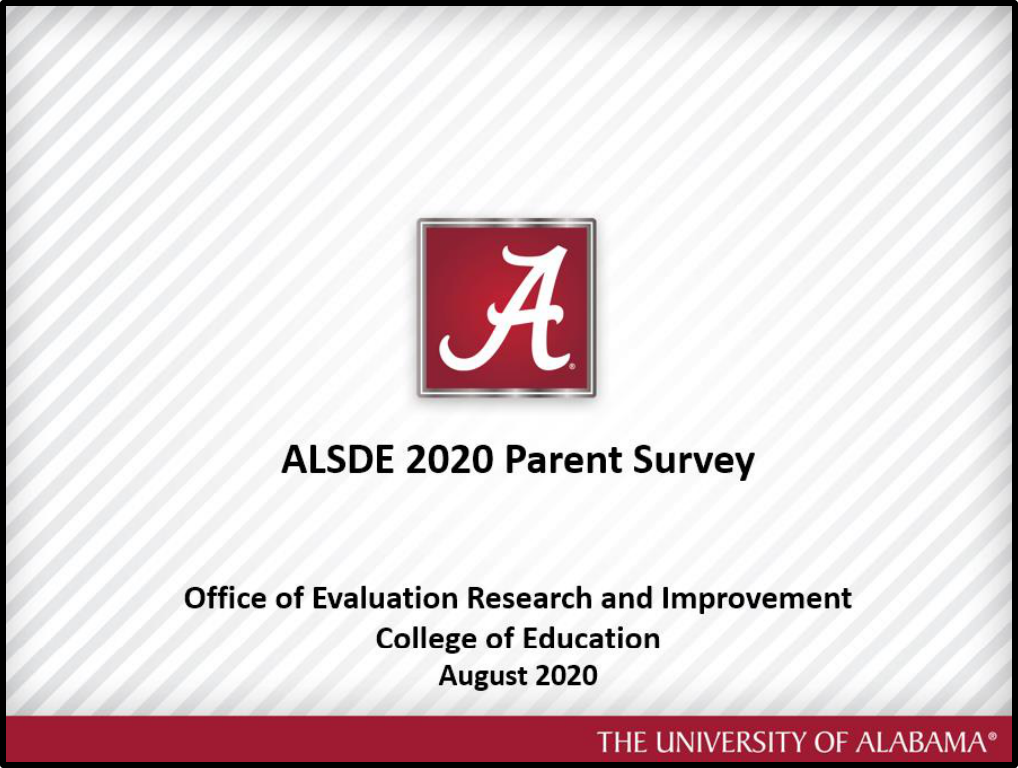
Page | 20
Appendix B. Initial Analysis
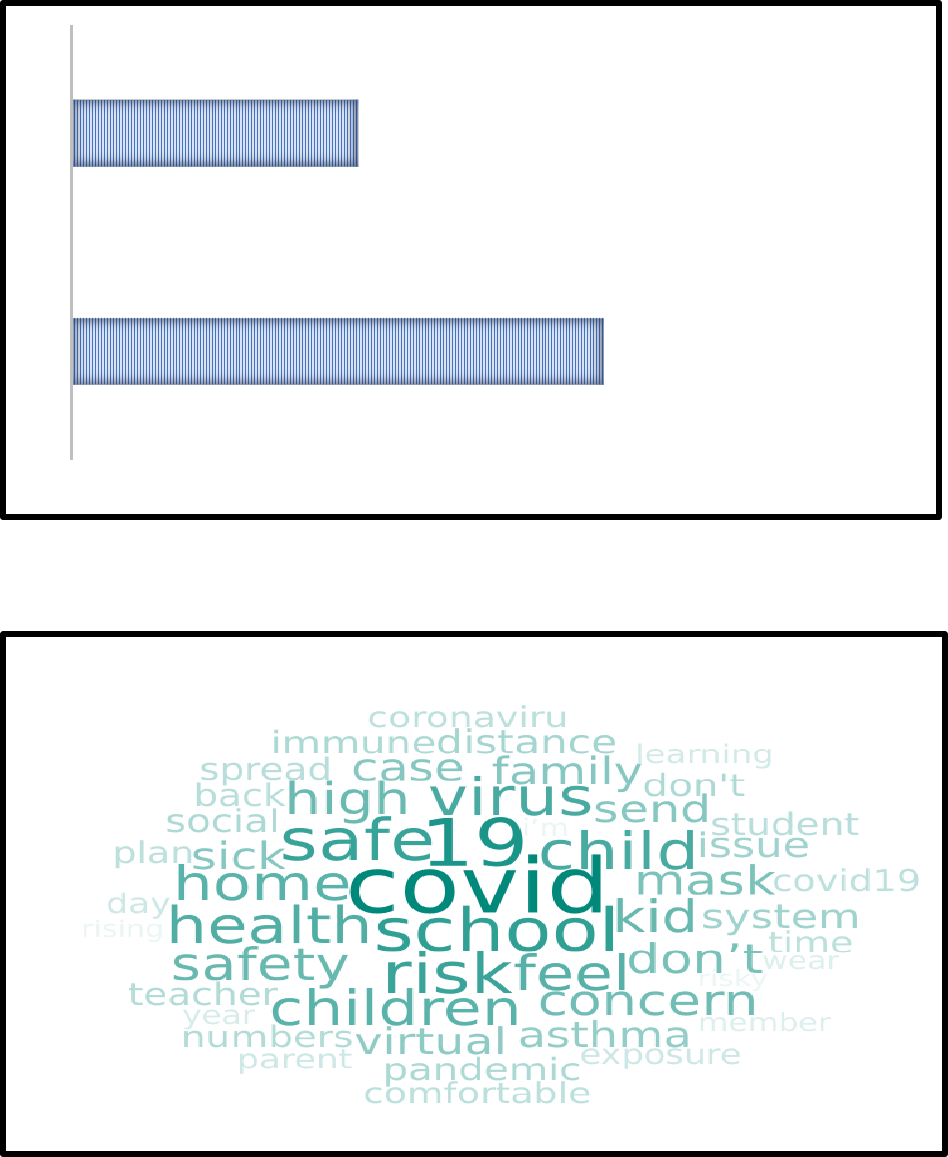
Page | 21
Q1-Are you planning on sending your children to school in a traditional classroom setting on
campus when schools reopen this fall?
Q1- If no, why not?
65%
35%
0% 20% 40% 60% 80% 100%
Yes
No

Page | 22
Q2 - How many children are in your household?
Q3 - How many children in your household are school-aged (grades K-12)?
28%
44%
20%
8%
0% 20% 40% 60% 80% 100%
1
2
3
4+
44%
39%
13%
4%
0% 20% 40% 60% 80% 100%
1
2
3
4+

Page | 23
Q4- Are any of your K-12 children assigned to special school programs? Check all that apply
Q5 - Do you feel comfortable allowing your children to ride the bus to get to school?
12%
13%
16%
59%
0% 20% 40% 60% 80% 100%
Special Education
Gifted Education
Advanced Placement Courses
No, my children attend conventional
classes.
29%
71%
0% 20% 40% 60% 80% 100%
Yes
No
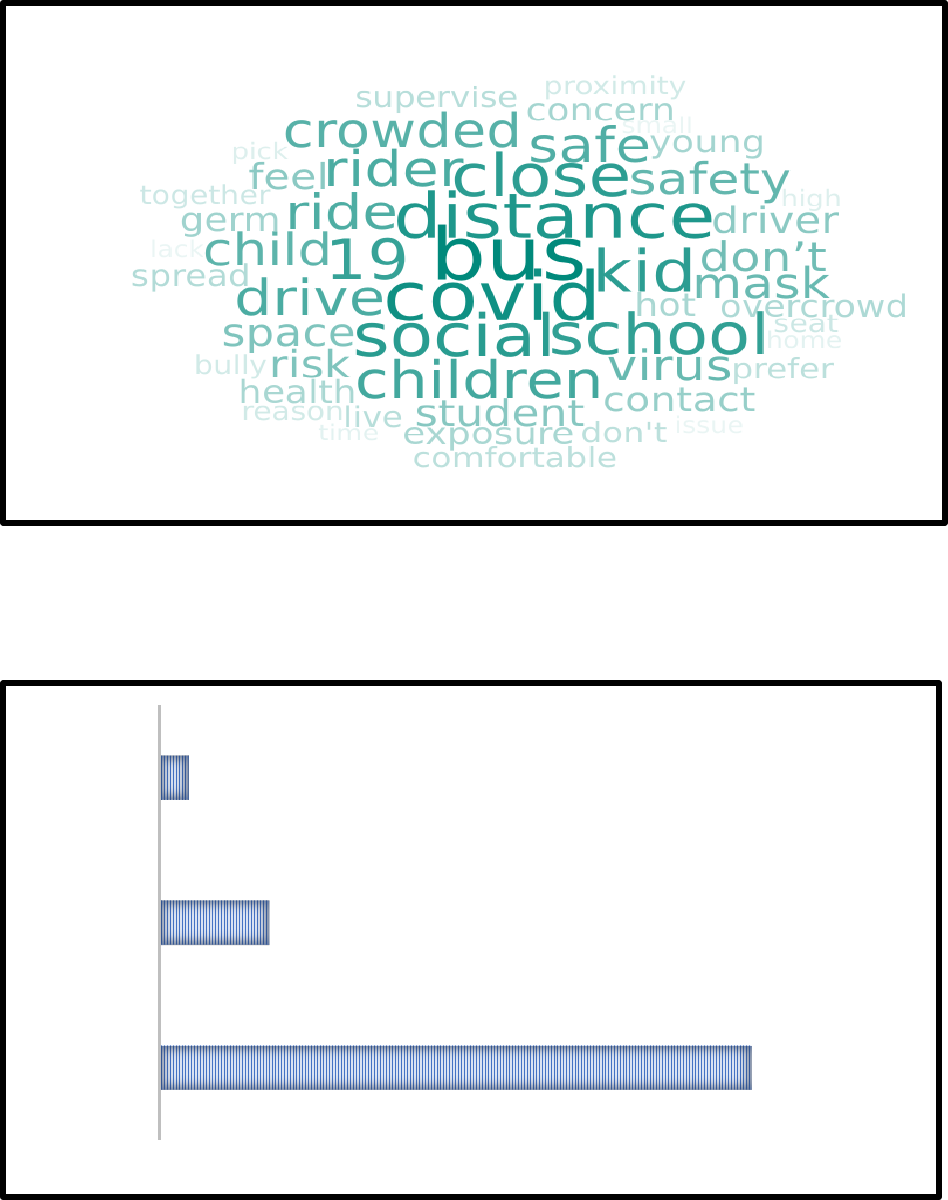
Page | 24
Q5 - If no, why not?
Q6 - Is high speed internet service available where you live?
81%
15%
4%
0% 20% 40% 60% 80% 100%
Yes
No
I don't know

Page | 25
Q7 - Do you have internet at home?
Q8- Where else do you or your child have access to the Internet where your child does
schoolwork? Check all that apply.
70%
18%
2%
9%
1%
0% 20% 40% 60% 80% 100%
Yes, I have high speed internet.
Yes, I have internet, but it is not high
speed.
I do not have internet in my house.
Only my phone has internet.
I have no access to the internet.
25%
11%
28%
11%
11%
7%
6%
2%
0% 20% 40% 60% 80% 100%
No other place
Work
Family
Friend's house
Library
Local business or restaurant
Park or another hotspot area
Other situation

Page | 26
Q9- Can you stream a YouTube or other video at home without it cutting out or freezing?
Q10 - What type of personal technological devices do you have access to at home? Check all that
apply
78%
22%
0% 20% 40% 60% 80% 100%
Yes
No
27%
68%
44%
24%
27%
87%
3%
2%
0% 20% 40% 60% 80% 100%
Desktop PC
Laptop
iPad
Android Tablet
Chromebook
Smart Phone
Other
None

Page | 27
Q11 - Does each child in your house have a personal technological device to access the internet?
Q12 - How many personal technological devices are used by K-12 children in your household?
69%
31%
0% 20% 40% 60% 80% 100%
Yes
No
9%
29%
33%
15%
15%
0% 20% 40% 60% 80% 100%
0
1
2
3
4+

Page | 28
Q13 - How many of the K-12 children in your household share devices in order to do their
schoolwork?
Q14 - What type of school-issued technological devices do you have access to at home? Check
all that apply
67%
12%
16%
4%
2%
0% 20% 40% 60% 80% 100%
0
1
2
3
4+
59%
34%
4%
4%
2%
1%
3%
0% 20% 40% 60% 80% 100%
I didn't receive a device from the school
Chromebook
iPad
Laptop
MacBook
Android tablet
Other

Page | 29
Q15 - Does your home have a television and cable, satellite dish, or an antenna?
Q16 - Did you know about the Alabama Public Televisions Learn at Home broadcast?
73%
25%
2%
0% 20% 40% 60% 80% 100%
Yes, I have a television with cable, satellite
dish or an antenna
Yes, I have a television but no cable,
satellite dish or antenna.
No, I do not have a television in my home.
16%
84%
0% 20% 40% 60% 80% 100%
Yes
No

Page | 30
Q17 - Did you watch Alabama Public Television's Learn at Home broadcast?
Q18 - Did you find Alabama Public Television's (APT) Learn at Home broadcast and related
supplemental material helpful?
25%
75%
0% 20% 40% 60% 80% 100%
Yes
No
85%
15%
0% 10% 20% 30% 40% 50% 60% 70% 80% 90%
Yes
No

Page | 31
Q19 - Have you used other online educational resources to support your child’s learning?
Q20 – Most Frequent online educational resources
55%
45%
0% 20% 40% 60% 80% 100%
Yes
No

Page | 32
Q21 - If you have a child or children in elementary school, do you feel prepared to support their
learning at home?
Q22 - If you have a child or children in middle/junior high school, do you feel prepared to
support their learning at home?
43%
36%
21%
0% 20% 40% 60% 80% 100%
I feel prepared to support my children's
school learning
Sometimes I feel like I can support my
children's school learning
I do not feel that I can support my
children's school learning
42%
38%
20%
0% 20% 40% 60% 80% 100%
I feel prepared to support my children's
school learning
Sometimes I feel like I can support my
children's learning
I do not feel that I can support my
children's school learning
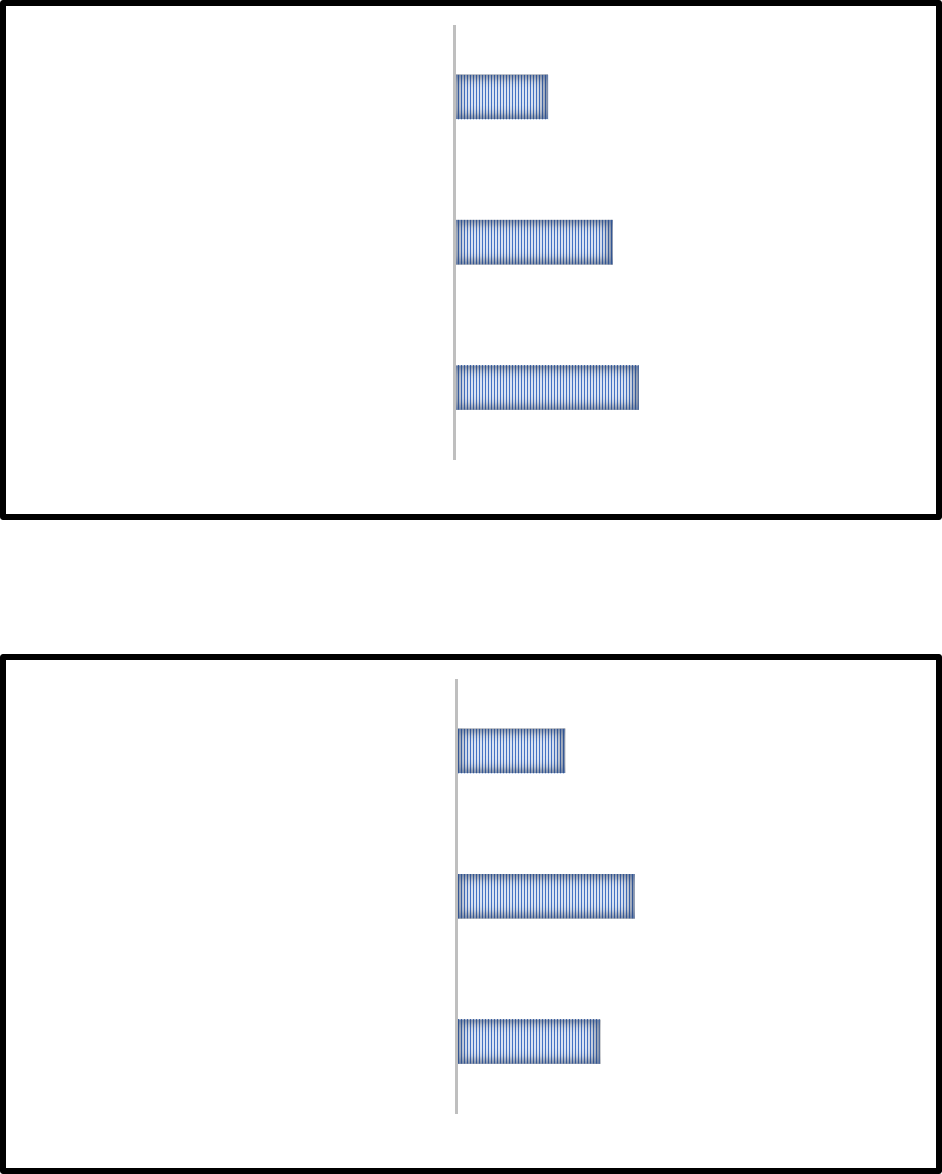
Page | 33
Q23 - If you have a child or children in high school, do you feel prepared to support their
learning at home?
Q24 - Generally, do you feel like your child/children learned well at home when campuses closed during
Spring 2020?
42%
36%
21%
0% 20% 40% 60% 80% 100%
I feel prepared to support my high
schoolers' school learning
Sometimes I feel like I can support my high
schoolers' school learning
I do not feel like I can support my high
schoolers' learning
33%
41%
25%
0% 20% 40% 60% 80% 100%
Yes, my children learned at home as if they
were still attending school
I feel like my child/children didn't learn as
much as they would have if they had
stayed at school
No, I feel like my children's learning
suffered during the campus closure

Page | 34
Q25 - Are you more or less likely to utilize at home learning for children after the Spring 2020
campus closure?
Q26 - How important is it for your child to have academic help with school?
56%
44%
1%
0% 20% 40% 60% 80% 100%
I am now more likely to utilize remote
learning
I am less likely to utilize remote learning
I already homeschool my children
69%
27%
4%
0% 20% 40% 60% 80% 100%
Very important
Important
Not very important

Page | 35
Q27 - How important is it for your child to have supervised enrichment opportunities after or
before school?
Q28 - If schools continue with remote learning, or a hybrid of remote and in-person learning,
how important is having a place, such as before or after school program, for your child to be
supervised and supported in accessing technology and using online learning on remote learning
days?
36%
33%
32%
0% 20% 40% 60% 80% 100%
Very important
Important
Not very important
33%
26%
41%
0% 20% 40% 60% 80% 100%
Very important
Important
Not very important

Page | 36
Q29 - How important is it for schools to work with community, faith-based, and employer
groups to help supervise children and help parents keep their jobs or look for jobs?
Q30 - How important is it to have after-school programs in or near schools to provide meals for
children?
55%
30%
15%
0% 20% 40% 60% 80% 100%
Very important
Important
Not very important
45%
32%
23%
0% 20% 40% 60% 80% 100%
Very important
Important
Not very important

Page | 37
Q31 - How important is it to have after-school programs in or near schools to help provide extra
learning supports?
47%
37%
16%
0% 20% 40% 60% 80% 100%
Very important
Important
Not very important
